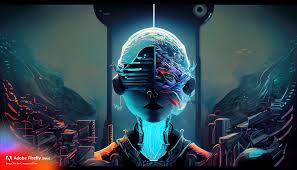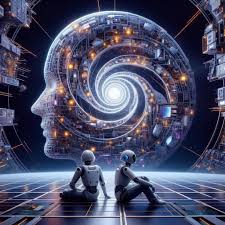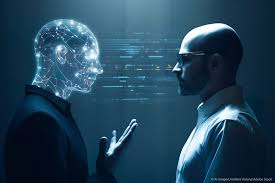Artificial Intelligence: Shaping Our Future Today.
ter. Artificial intelligence (AI) is changing the world fast. It's making things possible that we never thought we could do. This field is opening up new ways for humans and machines to work together.
AI has brought about huge changes in technology. It's changing how we work and live. It's making things like robots and systems that can talk to us bet
At the heart of AI is a deep understanding of how machines learn. This includes things like neural networks and cognitive computing. These technologies let AI do things that humans can't, like learn and make decisions fast.
Exploring AI takes us on a journey of discovery. It shows us how AI can change many areas, like healthcare and how we manage things. AI is making a big difference in how we live and work.
In the next pages, we'll dive deeper into AI. We'll look at how it works and its many uses. Join us as we explore the exciting world of artificial intelligence and see how it's shaping our future.

Key Takeaways
- Artificial intelligence is a transformative force, redefining the boundaries of technology and reshaping our world.
- AI has revolutionised industries, enhanced human capabilities, and challenged traditional ways of thinking.
- The core of AI's revolution lies in machine learning, neural networks, and cognitive computing.
- AI's impact is felt across a multitude of industries, from healthcare to supply chain management.
- Exploring the intricacies of AI unveils the secrets that are shaping our future today.
Decoding the Realm of Artificial Intelligence
Artificial intelligence (AI) is changing the game in many fields. It's making big waves in how we solve complex problems. Understanding AI's basics is key to grasping its power.
Unveiling the Essence of AI
AI is a broad field with many tools and techniques. It includes machine learning and natural language processing. These tools help AI systems do tasks that humans used to do, like recognizing patterns and making decisions.
AI: A Catalyst for Transformation
AI's impact goes beyond tech. It's driving change in healthcare, finance, transport, and more. AI automates tasks, improves decision-making, and finds new insights. This helps businesses and people work better and be more creative.
|
Sector |
AI-Driven Transformation |
|
Healthcare |
Precision diagnostics, personalised treatment plans, and enhanced drug discovery |
|
Finance |
Predictive analytics, fraud detection, and automated investment strategies |
|
Transportation |
Autonomous vehicles, traffic optimisation, and fleet management |
|
Manufacturing |
Robotic automation, quality control, and supply chain optimisation |
AI's growth means endless possibilities for change in different industries. By using AI, we can open up new chances for innovation and shape the future.
The Rise of Machine Learning
Artificial intelligence is growing fast, with machine learning at its heart. It lets computers learn from data and predict outcomes. This is leading to big leaps in predictive analytics.
Machine learning is all about finding patterns in big datasets. It uses different methods like supervised, unsupervised, and reinforcement learning. This way, machines get better at tasks over time. It's opened up new areas like natural language processing and computer vision.
Machine learning is great at solving complex problems that old ways can't handle. It uses stats and optimisation to find hidden links and make precise forecasts. This has changed finance, healthcare, and e-commerce, making decisions smarter with predictive analytics.
|
Technique |
Description |
Applications |
|
Supervised Learning |
Models are trained on labelled data to make predictions or classify new inputs. |
Image recognition, spam filtering, fraud detection. |
|
Unsupervised Learning |
Models discover hidden patterns and structures in unlabelled data. |
Customer segmentation, anomaly detection, recommendation systems. |
|
Reinforcement Learning |
Models learn by interacting with an environment and receiving feedback. |
Game-playing algorithms, robotics, resource allocation. |
Machine learning is changing the world in big ways. It's behind things like personal recommendations and self-driving cars. The future of AI is closely linked to machine learning's growth and its ability to open up new areas.
https://youtube.com/watch?v=4RixMPF4xis
Natural Language Processing: Bridging the Communication Divide
In the world of artificial intelligence, natural language processing (NLP) is a key technology. It lets machines understand and talk like humans. This is changing how we work and communicate with technology.
Enhancing Human-Machine Interactions
NLP has changed how we use technology. Now, we have virtual assistants and chatbots that talk to us. They understand our language, making our interactions with machines smoother.
Language Models: Powering Conversational AI
Language models are at the heart of this change. They learn from lots of text data. This lets them understand and respond to us in a way that feels natural.
The growth in natural language processing, conversational AI, and human-machine interaction is exciting. It's making technology a part of our everyday lives. We can now talk and work with machines in a way that feels natural and easy.
"Natural language processing is the key to unlocking the true potential of human-machine interaction, transforming the way we engage with technology."
Neural Networks: The Brain Behind AI
At the heart of artificial intelligence are neural networks. These structures mimic the human brain, allowing machines to learn and make decisions. This was once thought impossible.
Understanding the Intricacies of Neural Architectures
Neural networks have layers of nodes, called artificial neurons. These neurons process information and pass it on, like our brain's neurons. The way these layers connect affects how well the network solves problems.
At the heart of neural networks are deep learning algorithms. These algorithms help the networks learn from large datasets. By adjusting connections, neural networks can improve their decision-making, making them very useful in AI.
"Neural networks are the foundation upon which the most advanced artificial intelligence systems are built. They are the brain that enables machines to learn, think, and make decisions in ways that mimic the human mind."
As researchers delve deeper into neural networks, AI's possibilities grow. These structures power virtual assistants and drive self-driving cars. Their impact is vast, shaping the future of technology.
Deep Learning: Empowering Artificial Intelligence
Deep learning is at the heart of the AI revolution. It uses complex neural networks to solve tough problems. This has led to big leaps in image recognition and natural language processing, changing how we use technology.
Deep neural networks can find detailed patterns in data. This skill lets AI do things like translate languages and predict outcomes. These tasks were once thought to be only for humans.
Deep learning's power comes from learning from data itself. It doesn't need humans to prepare the data. This means AI can find insights and make predictions that were hard to imagine before.
The future of AI looks bright with deep learning leading the way. It will help make self-driving cars and improve healthcare. These advancements will shape our world for years to come.
"Deep learning is the most powerful machine learning technique of our time, and it's transforming every industry." - Andrew Ng, co-founder of Coursera and former chief scientist at Baidu.
|
Characteristic |
Deep Learning |
Traditional Machine Learning |
|
Feature Engineering |
Automatic feature extraction from data |
Manual feature engineering required |
|
Performance on Large Datasets |
Excels with large, complex datasets |
Limited performance with large datasets |
|
Scalability |
Highly scalable as dataset and complexity increases |
Limited scalability as dataset and complexity increases |
|
Accuracy |
Achieves state-of-the-art performance in many domains |
Varying performance depending on problem and feature engineering |
Cognitive Computing: Mimicking Human Cognition
In the world of artificial intelligence, cognitive computing is a new and exciting area. It aims to make machines think like humans, solving complex problems and making smart decisions. We will look into what makes cognitive computing special, including how it represents knowledge and makes decisions.

The Role of Knowledge Representation
Knowledge representation is key in cognitive computing. It's about organising and storing information in a way that AI systems can understand the world. By using lots of data, these systems can build detailed knowledge graphs. This lets them reason and make decisions like humans do.
Reasoning and Decision-Making in AI Systems
Reasoning and decision-making are also crucial in cognitive computing. AI systems need to be able to look at complex situations, weigh different factors, and make logical choices. With advanced algorithms, they can tackle tough problems, predict outcomes, and choose the right path.
By using cognitive computing, knowledge representation, reasoning, and decision-making, AI can do more than just follow rules. It can think and act like a human, solving problems and making decisions on its own. This could lead to new ways of solving problems, supporting decisions, and working together with humans.
|
Attribute |
Description |
|
Knowledge Representation |
The systematic organisation and storage of information, enabling AI systems to develop a comprehensive understanding of the world. |
|
Reasoning |
The ability to analyse complex situations, weigh multiple factors, and arrive at logical, well-reasoned conclusions. |
|
Decision-Making |
The process of navigating challenging scenarios, anticipating potential outcomes, and making choices that align with desired objectives. |
"Cognitive computing empowers machines to navigate challenging scenarios, anticipate potential outcomes, and make choices that align with desired objectives."
Artificial Intelligence Algorithms: The Driving Force
At the heart of artificial intelligence (AI) are complex algorithms. These are the basic parts that make machine learning and predictive analytics work. They come in many types, from supervised to unsupervised, and keep getting better. This evolution opens up new ways for us to use technology.
Supervised learning algorithms are great at things like recognizing images and understanding language. They use labelled data to learn and predict. On the other hand, unsupervised learning finds patterns in data without labels. Reinforcement learning algorithms learn by trying different things and getting rewards.
|
AI Algorithm |
Description |
Applications |
|
Supervised Learning |
Algorithms that learn from labelled data to make predictions |
Image recognition, natural language processing, predictive analytics |
|
Unsupervised Learning |
Algorithms that identify patterns in unlabelled data |
Clustering, anomaly detection, dimensionality reduction |
|
Reinforcement Learning |
Algorithms that learn by trial and error, optimising for rewards |
Game AI, robotics, autonomous decision-making |
As AI grows, these algorithms get smarter. They help machines solve harder problems. The key to these advances is the ongoing improvement of these algorithms. This includes ai algorithms, machine learning, and predictive analytics.
"Algorithms are the new bricks and mortar of the digital world."
Predictive Analytics: Leveraging AI for Informed Decisions
In today's world, predictive analytics is key for making smart choices. It uses artificial intelligence (AI) algorithms and machine learning to predict what will happen next. This helps businesses find patterns and insights in big data.
Predictive analytics uncovers hidden trends in data. AI models look at past data, find important factors, and make accurate forecasts. This helps in planning and making decisions. It's used for many things, like knowing when customers might leave or when markets will change.
|
Key Benefits of Predictive Analytics |
Noteworthy Applications |
|
|
By using predictive analytics, AI algorithms, and machine learning, companies can stay ahead. They make better choices and grow in a fast-changing world.
"Predictive analytics is not about predicting the future, but about understanding the present in a way that allows us to make better decisions today."
As things change fast, using predictive analytics will be more important. It helps companies face challenges and grab new chances.
Conclusion
Artificial intelligence is changing our world in amazing ways. It's making us better and driving new ideas in many fields. This tech is leading us into a future full of progress and growth.
Machine learning, natural language processing, and neural networks are creating big chances for us. They help us talk better, think like humans, and make smart choices. This tech is changing how we live, work, and connect with each other.
As AI keeps getting better, it will change our society even more. By using this tech, we can explore new ideas, work smarter, and reach our full potential. This will make our future brighter, more connected, and full of possibilities.

FAQ
What is artificial intelligence?
Artificial intelligence (AI) is a field of computer science. It aims to create systems that can do things humans do, like learn and solve problems. These systems can understand and interpret their surroundings.
How does machine learning work?
Machine learning is a key part of AI. It lets computers learn and get better over time without being told how. They use data to find patterns and make decisions.
What is natural language processing?
Natural language processing (NLP) is a part of AI. It helps machines understand and use human language. This lets computers analyse and make sense of human speech and writing.
How do neural networks work?
Neural networks are inspired by the brain. They are made up of nodes that can learn from data. This helps them solve problems and find patterns, just like our brains do.
What is deep learning?
Deep learning is a type of machine learning. It uses complex neural networks to mimic the brain. These algorithms can solve tough problems, like recognising images and understanding language.
What is cognitive computing?
Cognitive computing aims to create systems that think like humans. They can see, learn, reason, and interact. These systems use AI to understand and make decisions in a human-like way.
What are AI algorithms?
AI algorithms are the heart of AI systems. They help machines learn, decide, and do tasks. There are many types, like supervised and unsupervised learning, and deep learning.
How does predictive analytics work with AI?
Predictive analytics uses data and AI to forecast future events. AI algorithms analyse big data to spot trends. This helps make accurate predictions for better decision-making.



You must be logged in to post a comment.